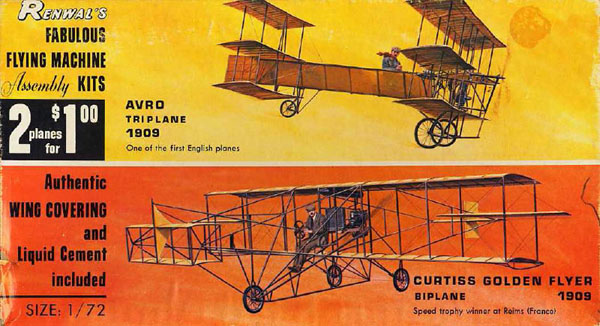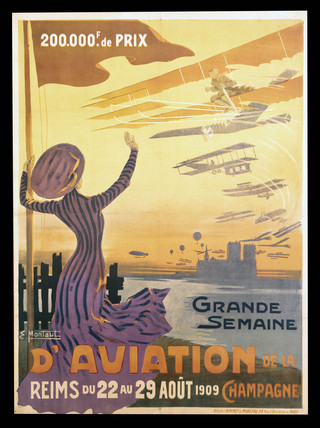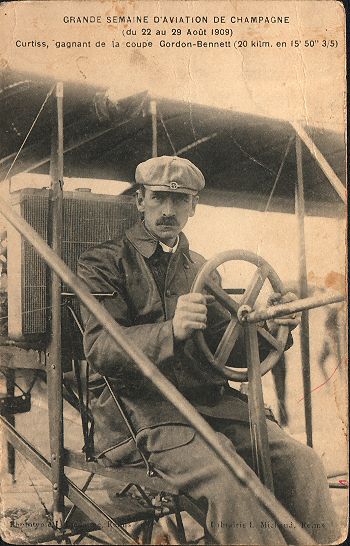
Renwal 1/72 Curtiss Golden Flyer / Reims Racer
By Tim Nelson
BACKGROUND
 One hundred years ago, during the week of 22-29 August, 1909, the world's first major international air meet was held at Reims, France. The festivities included exhibitions, altitude / speed / endurance contests, and other events, drawing several hundred thousand people to view the new cutting edge of technology: powered flying machines. On 28 August 1909, the meet culminated with a "main event" air race featuring a who's who of early aviators and their designs.
One hundred years ago, during the week of 22-29 August, 1909, the world's first major international air meet was held at Reims, France. The festivities included exhibitions, altitude / speed / endurance contests, and other events, drawing several hundred thousand people to view the new cutting edge of technology: powered flying machines. On 28 August 1909, the meet culminated with a "main event" air race featuring a who's who of early aviators and their designs.
Glenn Curtiss intended to race his Herring-Curtiss "No. 1" Golden Flyer (sometimes referred to as the Gold Bug) at Reims but crashed it during preparations in July 1909. He was able to get another aircraft built quickly, "No. 2" (quite sensibly dubbed the "Reims Racer"), in time to compete. It was a slightly larger, but lightened Golden Flyer configuration. The Reims race course required 2 laps for a total distance of 20 km (12.43 miles). The event was based on minimum time to complete the race distance, not head-to-head flying. Curtiss won the event and the Gordon Bennett Trophy with an electrifying 47 mph average speed, a new world record. Curtiss's time was faster than crowd favorite Louis Bleriot, a French hero barely a month after his famous English Channel crossing, by a scant 5.8 seconds.
 Curtiss won more events with the same aircraft a month later at the large air meet in Breschia, Italy. He also had great success at the first air meet in the US (at Dominguez Hills, CA) in October, 1909, upping the air speed record to 55 mph in the process. Curtiss then apparently loaned or leased the Reims Racer to Charles Hamilton, who cracked it up in exhibitions at the Meadows Race Track in south Seattle, WA in March, 1910 (these were the first ever airplane flights in Seattle, at the site of modern day Boeing Field). It was repaired and Hamilton flew it many times again, but what became of it after 1910 is uncertain.
Curtiss won more events with the same aircraft a month later at the large air meet in Breschia, Italy. He also had great success at the first air meet in the US (at Dominguez Hills, CA) in October, 1909, upping the air speed record to 55 mph in the process. Curtiss then apparently loaned or leased the Reims Racer to Charles Hamilton, who cracked it up in exhibitions at the Meadows Race Track in south Seattle, WA in March, 1910 (these were the first ever airplane flights in Seattle, at the site of modern day Boeing Field). It was repaired and Hamilton flew it many times again, but what became of it after 1910 is uncertain.
Glenn Hammond Curtiss himself needs no introduction to aviation history enthusiasts, so we'll not devote text to his many achievements here.
NorthWest Scale Modelers (NWSM) is a Seattle area modeling club which meets monthly at the Museum of Flight (MoF). NWSM stages a quarterly, themed model display in the MoF lobby. This month, we install a display celebrating the centennial of air racing (see the upcoming September IM for a report), near the very spot where the Reims Racer crashed in 1910. No collection of air racing models is complete without the Curtiss Reims Racer anchoring the front end; when I discovered a few months back that Renwal made a kit of it, I knew I had to build it, and quick.
KIT
Renwal produced a lot of really cool kits in the 1950s and 60s, including things like cut-away nuclear submarines and atomic cannons. The Renwal Curtiss Golden Flyer was part of their series of 1/72 "Fabulous Flying Machines" kits released in 1960s. The six model kits were sold in three pairs ("2 for $1!"):
- Curtiss Golden Flyer and Avro Triplane
- Antoinette 1908 Monoplane and Voisin Farman 1908 Biplane
- Wright 1903 Flyer and Bleriot 1909 Monoplane
The parts, the vast majority of which are struts, ribs, spars, etc., are molded in black styrene.
The novelty of these kits was Renwal's "aeroskin" material that is intended to represent airplane fabric. It is a porous material with the feel of tissue, but more durable. It is installed by tracing and cutting to shape, then affixing to the underlying styrene strucure by judicious application of liquid solvent cement. The softened styrene works its way up into the aeroskin fibers, and forms a surprisingly strong bond when is hardens. Working from the middle out on each surface, you keep it as taut as possible and trim off the excess with a sharp blade when completely dry.
The acepilots.com site contains an account of the Reims race, and a detailed contemporary description of the basic Curtiss biplane design and construction of this period. Of interest for this model is the following:
"The main cell and smaller parts are made of ash and spruce, and the large outriggers, of bamboo. Several members of the frame meet at the front wheel. Small cables as well as wires are used for bracing."
Despite the relatively crude 1960s molds, this kit actually simulates those bamboo outriggers! But man, are they thick!
CONSTRUCTION
The Golden Flyer / Reims Racer kit, like its companion Avro Triplane and the four other subjects in this series, is basically accurate in major dimensions and features (the aileron size and shape is not quite right but I lived with it). The single biggest accuracy issue is that all struts are overscale in thickness by roughly a factor of two, making them suitable for about 1/35 scale rather than 1/72. If you replaced all those struts with something more to scale, you'd pretty much have a scratchbuild rather than a kit build. I didn't have time for that in this deadline project, and I was charmed by the aeroskin and "bamboo" struts and wanted to use them. However, I did make some strategic upgrades at a few key visual focal points. Here is a list of the most significant modifications:
|
|
|
|
|
|
- Revised wheel mounting provisions to accept spoked wheels
- Scratchbuilt a new pilot seat with belts made from Tamiya tape
- Replaced the control arm from the pilot's yoke to the front elevator with a thinner diameter strip of brass rod
- Replaced thick landing gear drag braces with scratchbuilt struts made from thin strip styrene
- Re-engineered assembly of some of those "members of the frame meeting at the front wheel"
- Repaired deformed propeller and added prop boss from spares bin
- Hand masked and airbrushed the racing number "8" on the rudder
- Added a tiny U.S. flag on a rear strut of the elevator (Curtiss used that as a slip indicator at Reims; yes, it has 46 stars)
Fit of several of the parts is vague, as are the instructions, and the kit generally suffers from some clumsy engineering here and there. However, there was no problem that any reasonably experienced modeler can't solve with enough motivation and time.
|
|
|
|
|
|
|
|
|
|
The look of the applied aeroskin is a reasonable facsimile of airplane canvas/linen/silk, and it does achieve the prototypical translucent effect. However, when applied over the black styrene, the black is starkly visible through the aeroskin (why didn't Renwal use medium brown colored styrene?). So, I dressed up the installed aeroskin with a couple of quick airbrush passes of Humbrol "Linen", which also served to add a bit of golden colo(u)r, as observers described this craft. Given that this is a 40+ year old kit, I like the look of the flying surfaces, but I have to say you could probably do a more convincing job with the typical small vintage aircraft model scratchbuild method of sheet styrene with embossed ribs and artful airbrushing.
My rigging here is an Impressionist effort, simply a representation of the major elements. This machine, like others of its time, was a rat's nest of wires; reproducing all of that in 1/72 scale on a deadline is not my idea of fun. I made use of the notches molded into the struts as anchors for the rigging, a concession to the deadline, the fragility of the model, and to sanity preservation.
The "Glenn Curtiss" figure, a must for our Museum of Flight display, is derived from a Preiser 1920s air passenger figure. A little sanding down of his hat was the only physical modification required, the rest was painting to ostensibly match a postcard of Curtiss taken at Reims during the 1909 air meet. And of course, he had to have the moustache, big even in 1/72 scale.
SUMMARY
This was a very enjoyable build, despite rigging and the looming deadline, of a very historically significant aircraft. I can't claim it was what my friend and our IM "Modeling Now and Then" columnist Scott Kruize calls a NABROKE (Nostalgic Aging Baby Boomer Real Old Kit Experience), because I never built one as a kid. Regardless, these old Renwal "Fabulous Flying Machine" kits are a lot of fun if you don't let yourself get bogged down with too many corrections and upgrades.
If you're in Seattle between now and November 5, come see the NWSM "Bent Throttles: 100 Years of Air Racing" model display at the Museum of Flight (and/or read about it here next month).
A special thanks to Museum of Flight Chief Curator Dan Hagedorn, and WW1 Aero magazine editor Carroll Gray, for their historical insights on this machine and its unlikely Seattle connection.
REFERENCES
https://www.centennialofflight.gov/essay/Explorers_Record_Setters_and_Daredevils/Reims/EX2.htm
https://www.airracinghistory.freeola.com/Reims.htm
Racing Planes and Air Races, Vol 1 (1909-23), Aero Publishers, Reed Kinert
The First Aviators, Curtis Prendergast, Time-Life "Epic of Flight" series
Race with the Wind, Birch Matthews, MBI Publishing Company
IPMS Racing and Records Special Interest Group, and associated journal "Bent Throttles" (see https://www.ipmsairrace.org/)
